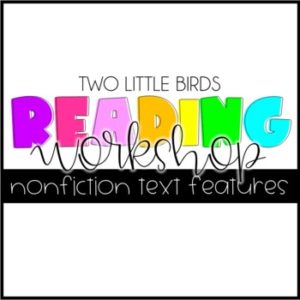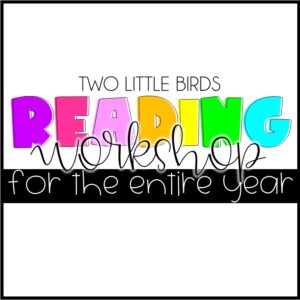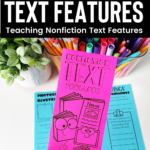As readers, we know the importance of using text features as we read. But, many students, especially struggling readers, do not use text features and simply skim over them in the text. Students must learn that the features of a nonfiction text are there to help them navigate the text and with that understanding, students will no longer ignore the text features.

It is important that we teach students WHAT text features are as well as HOW to use them. When you break down text features and look at them in groups to help students understand each feature, students will be able to use the text features to deepen their understanding of nonfiction text.
What Are Nonfiction Text Features?
As students get older, they are required to read more nonfiction text. And nonfiction text can look different than the fictional stories that students are used to reading. They are structured differently and have features that are not found in other texts. While a fictional story may have a distinct plot, the main character, and setting; a nonfiction text has features that are important to understanding the text as well. Such as photographs, captions, headings, keywords and bullets, and more.

Things to Consider When Teaching Text Features
- It is a more abstract concept than most reading skills taught. Students will be able to look and find the text features directly in the text.
- Using the text features to help understand the text is where the problem lies for some students. While students may notice text features, they do tend to skip over them. They may skip a heading to get to the “meat” of the text. They may not read captions of photos or illustrations. A diagram or a table may just seem like a picture and not something they need to better understand the text.
- We must help students understand what each text feature can teach them and how it helps in understanding the text.
- We must encourage students to use text features on their own. When they are unprompted and reading a nonfiction text, will they skim over the text features or use them properly? We must help them create habits that will continue while they are independently reading.
- Once students notice text features and understand their importance, we must help them analyze the information the text features are giving us.
Teaching Text Features
Getting Students to Notice Text Features
Students can do a scavenger hunt to look for text features in nonfiction text. Have a variety of nonfiction texts available as mentor text for students to choose from to look through. Having a wide variety of topics and kinds of nonfiction text will expose students to different types of print as well as different text features. When they are looking through the text trying to find the text features, they will notice them and remember them more.
Understanding Each Text Feature
Students can use text features to help their understanding when they KNOW what the text features are and how they help them as readers. Carefully review each text feature and it's importance to a nonfiction text. With a variety of text to choose from, students will see that a text includes many features.
Create an anchor chart as you review each text feature and keep it as a reference for your students to use as they read nonfiction text. Students can also create their own mini-anchor chart in their reader's notebooks.
Using Text Features
So by now students have looked for specific text features and reviewed each one and how it helps them as readers. Now…it's time to put those skills into action! They must actively use the text features as readers of nonfiction text. Using mentor text and actively modeling how you use text features will show students how they can use them as they read on their own too. Point out how the diagrams and captions help you understand the text, the headings help grasp the main idea, the bold words indicate a word you may not know…there are so many opportunities to think aloud and model as you read.
Students can continue to use their scavenger hunt as they find features while reading on their own too!
When Students Are Struggling with Nonfiction Text Features
When students still seem to be struggling with using the text features and skimming over them to stick to the plain text, you can use shorter text and try to draw their attention to the text features. Choose an excerpt of a longer text or a short passage where it is easier to point out the features and model for students how you notice, understand, and use the text feature.
When text features are broken down and studied carefully, students will be able to notice and analyze them in their nonfiction texts.
You can grab a free scavenger hunt to use with your students below!
Shop all of the resources in this post here:
Happy Reading!








